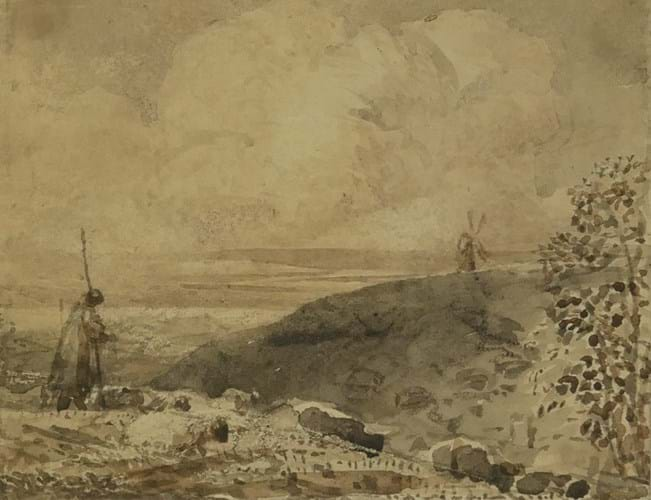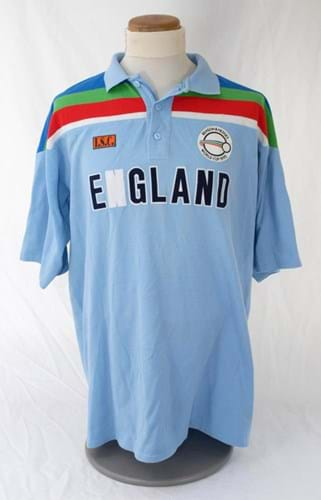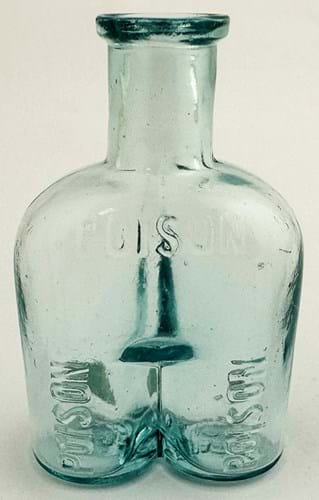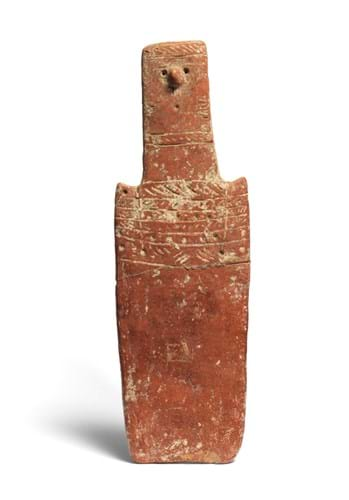1. Sir Ian Botham’s 1992 World Cup shirt – £11,000
England cricketer Sir Ian Botham sold a cache of memorabilia from his international and club career at an auction on July 15. The sale was conducted by Knight's Auctioneers of Norwich in the long room at The Oval, Surrey's home ground.
The famous all-rounder parted with over 240 items including those relating to ‘Botham’s Ashes’, the 1981 series when his heroics with bat and ball made him a household name. The stump ‘Beefy’ ripped out of the ground after the miraculous win at Headingley (at one point in the game an England win was quoted at 500-1) came for sale with a guide of £10,000-15,000 along with the ball he used to take five wickets for one run in a lethal spell that inspired England to victory in the next test at Edgbaston (estimate £15,000-20,000).
The Duncan Fearnley stump, which has been marked in ink 'Headingley 81' by Botham took £11,000 and the Edgbaston cherry £20,000.
His man-of-the match medal from Headingley went at £19,000, more than double the pre-sale estimate.
Botham joined Somerset County Cricket Club aged 13 and made his senior debut aged 17. Between 1977 and 1992, he played in 102 test matches, scoring 5200 runs including 14 hundreds and taking 383 wickets.
Botham retired following the 1992 World Cup in Australia. The England blue one day top he wore for his swansong (England lost to Pakistan in the final), was estimated at £600-900 but was competed to £11,000.
The sale came as England are facing Australia once more in the 2023 Ashes series. So far, despite Botham-like heroics from the current England captain Ben Stokes, the Aussies are 2-1 up.
2. Poison bottle – £11,000
It was under the Arsenic Act of 1851 that the sale of toxic substances – some of them used for murder most foul – first became more regulated.
However, it was not until the Poisons and Pharmacy Act of 1908 that it became a legal requirement for a bottle containing poison to carry a warning.
In the intervening half a century, at a time when it was often necessary to reach for medicine by candlelight, the marketplace had responded to the need for safer bottles with an array of patent applications from chemists, doctors and glass companies for containers, which would be recognisable by touch and colour. The most common in blue and green glass were moulded with ridges and grooves.
The most collectable today are the quirky models that assumed a range of shapes from skulls to coffins.
A rare type patented in 1905 is a bottle formed with two conjoined cylinders and a singe neck. The so-called ‘binoculars’ poison, embossed with the word Poison and a figure of eight reading 8482 and Patent 1905, is known in different sizes and colours but all of them are in the ultra-rare category.
The 3.75in (10cm) example in aqua glass that was offered at South Yorkshire bottle and advertising specialist BBR Auctions on July 2 is the only recorded version in this colour and size. The estimate of £3000-4000 was based on a previous private sale of a similar bottle but what would happened when the open market was tested? Some 49 bids later the hammer fell to a determined phone bidder at £11,000.
3. Shoreham period Samuel Palmer watercolour – £27,000

Bright Cloud, Shepherd and Windmill, a Shoreham period watercolour by Samuel Palmer, £27,000 at Swan Fine Art
This Shoreham period watercolour by Samuel Palmer (1805-81) came for sale at Swan Fine Art in Tetsworth, Oxfordshire on July 12-13. Painted in the Kent artists’ colony c.1831-32, Bright Cloud, Shepherd and Windmill has a full provenance having been owned by Palmer’s wife, then by her friend Mrs Bryan Cook and later by her daughter Una Hook.
It was sold at Godalming saleroom Messenger May Baverstock, in 1980 where it was acquired by the Leger Galleries.
It was exhibited at the V&A in 1926 and included in Raymond Lister’s Catalogue Raisonné of the works of Samuel Palmer (1988) and Geoffrey Grigson’s Samuel Palmer: The Visionary Years (1947). Lister believed the watercolour and wash on brown paper was one of five small-scale monochrome studies for The Bright Cloud, a large oil and tempera work on a mahogany panel in the City of Manchester Art Galleries. Some of the research was affixed to the back of the frame alongside two Leger gallery labels.
Any fully authenticated Shoreham period Samuel Palmer is a rarity on the market. It was estimated at £3000-5000 but did rather better, selling via thesaleroom.com for £27,000.
4. Doulton & Watts Nelson flask – £3400
The salt glazed portrait jug of Nelson by Doulton & Watts of Lambeth is considered the first character jug made by Doulton. First issued c.1821, a year after a gifted young potter John Doulton had partnered with his older ex foreman, John Watts, it was made in a number of different styles and sizes.
The most common variant is a bust portrait (one that was reissued by Doulton around the time of the Trafalgar centenary) but this one measuring an impressive 19in (42cm) high depicts the Admiral half-length wearing full awards and decorations. It is inscribed to one medal Nile 1798 and to the base Trafalgar 1805, England expects every man to do his duty. This model is sometimes seen as a jug with handle but is particularly rare in this bottle form – the cockade of the bicorne hat forming the neck.
While a Doulton & Watts bust portrait jug might bring under £200 today, this one, offered for sale at Thomson Roddick in Carlisle on July 13, was estimated at £400-500. In fact, helped by its good condition and excellent glaze, it brought an impressive £3200 – nigh on twice as much as a handful of other of this type have brought in recent years.
5. Charles Darwin proof copy – £300,000
Christie’s Books and Manuscripts sale on July 12 included a remarkable copy of Insectivorous Plants by Charles Darwin (1809-1882).
Sent to the publisher John Murray in the idle of 1875, these are Darwin’s own corrected proof sheets, showing substantial revisions in his own hand. The emendations or cancellations amount to around 1300 words.
While the existence of these annotated proof sheets has been known from Darwin’s correspondence, they have not been published and are as yet unrecorded by Darwin Online.
Christie’s said the pages, housed in a modern green morocco leather case, had been acquired by the vendor from the bookseller Jonathan Hill in 1990. Estimated at £150,000-200,000, they took £300,000.
After many years spent labouring on evolution and sexual selection, by 1873 Darwin returned his attention to his beloved plants. Published in July 1875, Insectivorous Plants was one of Darwin’s final works. His fears that such a technical book would ‘flop’ proved unfounded: after the first 1700 copies sold straight away; 2000 more copies were printed quickly and 1000 more run off in 1876.
6. Cypriot terracotta figure – £42,000
Most terracotta plank figures from Bronze Age Cyprus have been found in Lapithos, a once important coastal centre on the north of the island. Cut from a single slab of red clay with an average hight around 25cm, these ‘idols’ assume a number of different forms from single figures to figures cradling infants and figures with two or three heads.
Exactly why they were made and who they depict is the subject of conjecture. They may recall cult statues of stone or wood that were placed in sanctuaries to honour a generic ancestor or fertility goddess.
Among the best-performing lots in Bonhams’ Antiquities sale on July 6 was this 23cm Cypriot terracotta plank figure from c.2000-1800BC. The patterns on the body most likely indicate a woven garment, overlaid with jewellery.
It is close in design and execution to another figure of this type in the Metropolitan Museum of Art, part of the fabled collection of Cypriot art assembled by the museum’s first director Luigi Palma di Cesnola (1832-1904).
Also part of its appeal was a half-a-century-old provenance to 1967 and a sale of the Collection de Mme S at the Drouot where it was photographed in the catalogue. It was purchased at the time by the collectors Jacques and Françoise Martinet and was one of three lots in the sale consigned by their family, now based in London.
The plank figure was estimated at £5000-7000 but, at £42,000, it became one of the most expensive of its type to come to auction.











